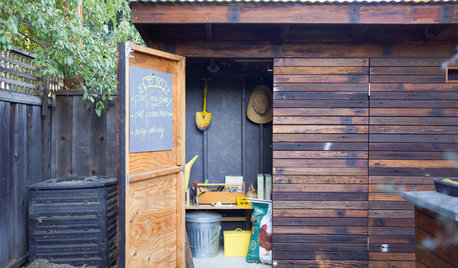If you look at the Soil/Compost forum FAQ page, you will find out that the MICROHERD is a term that we organic gardeners use to refer to all the billions and billions of beneficial microbes that help us digest and produce our compost.
One of our composting experts and friends on this site, David Hall (DcHall_San_Antonio), recently gave a great list of some of the major benefits from soil high in organic matter:
************************************************************
"Chemical fertilizers rely on an assumption that plants only need three elements to survive and thrive. Nitrogen, phosphorus, and potassium are those three. This is the equivalent of saying that we need protein, fat, and sugar to live. While this may be mostly true, pure protein, pure fat, and pure sugar do nothing to supply the vitamins, minerals, and diverse supply of bacteria and fungi in our diets.
Here is a list of a dozen things that you can do with organically fed soil that cannot be achieved with conventional chemical feeding.
1. Decompose plant residues and manure to humus.
2. Retain nutrients in the form of stable humus.
3. Combine nitrogen and carbon to prevent nutrient loss.
4. Suppress fungus and bacterial diseases.
5. Produce plant growth regulators.
6. Develop soil structure, tilth, and water penetration/retention.
7. Clean up chemical residues.
8. Shift soil pH to neutral and keep it there.
9. Search out and retrieve nutrients in distant parts of the soil.
10. Decompose thatch and keep it from returning.
11. Control nitrogen supply to the plants according to need.
12. Pull minerals out of inorganic soil components for plants.
Soil microbes need sugar and protein to thrive. When you apply synthetic ferts, none of the things on this list gets done. The microbes normally get sugar from plant roots. Protein in nature comes from dead insects, plants, and animals. The organic gardener applies protein artificially in the form or organic fertilizers. It is usually in the form of a ground up meal made from plants and animals to try to replicate the natural process."
*******************************************************
There are several ways to make compost or organic matter. You can do it in a compost pile or bin. You can do trench or sheet composting. You can do earthworm or vermicomposting. You can even make liquid compost in various compost tea recipes. No matter how you make it, it all works because of the microherd.
In simple laymen terms, there are basically two large groups of microbes that are important for all composting techniques:
AEROBIC MICROHERD - All microbes that absolutely need oxygen in order to survive.
ANAEROBIC MICROHERD - All microbes that don't need oxygen to survive, but may or may not use oxygen in their life cycles.
All soil/compost microbes are important for proper soil health and compost decomposition. In addition to the soil microbes, you got earthworms, sowbugs, soldier fly larvae, etc. However, even inside the internal organs and cells of these larger beneficial soil organisms, you still got the amazing soil/compost microbes working constantly digesting pounds and pounds of insoluble organic material into soluble nutrients and constantly improving the soil's health and texture.
When we use the term microbes or microherd, we mean not only just bacteria, but also fungi and other species. NOTE: All forms of microbes need water in order to to live and grow. That's why we need at least some form of moisture in composting and in tea brewing.
Bacteria species can be aerobic or anaerobic. Fungi is always aerobic. Some species like yeast can go dormant and be anaerobic for a season in some cases. Bacteria is like microscopic animals in our compost piles. Fungi is like little small plants that don't need sunlight for photosynthesis like their larger plant cousins, that all help digest and break down large portions of organic matter in compost and in soil.
All microbes also need carbon and nitrogen. In composting, the carbons are normally in the form of carbohydrates, and the organic nitrogen is normally in the form of proteins. The carbons are supplied by composting materials called "BROWNS". The organic nitrogen is supplied by composting materials called "GREENS". The carbons keep the microbes alive while they constantly digest the OM. The nitrogen helps the microbes grow and reproduce into larger and larger numbers in the compost for faster decompostion.
SOME BASIC ADVANTAGES OF THE ANAEROBIC MICROHERD:
1. They don't need our help in composting to work! For the carefree composters, these guys make our life easier. They work daily digesting insoluble OM without our turning, or watering, or aerating the compost piles, trench composting styles, or simple anaerobic compost teas.
2. They conserve more organic nitrogen in composting than their aerobic microbial cousins do in composting. One disadvantage of aerobic hot composting is that it takes more organic nitrogen to keep the aerobic microbes alive and well than it does the anaerobic microbes.
3. Many species can even fight many plant/soil diseases and repel many pests due to the increase of microbial activity produced by composting. One of the disadvantages of aerobic hot compost is that many of the important disease fighting
microbes that are needed in the soil are killed off with the bad microbes by the extreme internal heat of an aerobic compost pile.
SOME BASIC ADVANTAGES OF THE AEROBIC MICROHERD:
1. They all grow faster than the anaerobic microbes! If you like your compost fast like I do, thank these aerobic guys for all their hard work. Because of the oxygen element, these guys can grow and breed at an incredible rate in composting! Normal carefree cold compost piles can take 6-12 months to turn to mature compost or humus. A super hot compost pile can turn the same organic matter (via the help of the aerobic microbes plus some extra organic nitrogen in the pile to fire them up a little bit) into mature compost or humus in 2-3 weeks to 2-3 months!
2. Internal heat is given off by aerobic microbes in the form of waste as they digest pounds and pounds of insoluble organic matter. This heat is the heat of an aerobic hot compost pile. This heat is important to sterlizing and breaking down many pathogens and mild disease issues that may appear in composting materials while cooking or brewing.
3. The internal heat given off by aerobic microbes is important in germinating and cooking off weed seeds that may be in composting materials.
4. The aerobic microbes because they grow faster than their anaerobic cousins, are actually more practical and more convenient for safer mature compost than mature compost produced by an anaerobic process. Particularly in making aerobic compost tea, the aerobic compost is superior in order to guarantee that no diseases, pathogens, or mild toxins will be grown and multiplied in the aerobic compost tea brewing process.
5. Aerobic compost always has a pleasant smell. One of the disadvantages of anaerobic organic matter, cold compost, or anaerobic teas are the offensive odors.
6. In aerobic tea brewing, these aerobic microbes are grown and multiplied at an amzing rate. There prescence in the tea creates sometimes a yeasty, pleasant forest floor smell. Other times, the aerobic microbes make create a foamy layer on the tea indicating that the aerobic guys are outcompeting their anaerobic cousins in the brewing process.
7. Aerobic teas can help digest and improve soil layers via organic mulches faster than anaerobic teas. If you use these teas as both a foliar feed and soil drench, you will get the maximum effect of these powerful biostimulants.
So in conclusion, as a wise organic gardener and composter, it's our job to balance and breed the appropriate aerobic and anaerobic microbes and other soil organisms that are necessary for healthy soil and plants.
Happy Gardening!













Related Discussions
How to grow microherd?
Q
Old-time gardening = organic gardening?
Q
Why specifically do organic gardeners avoid chemical fertilizers
Q
Why do we spend so much time, effort and $$$$ gardening?
Q